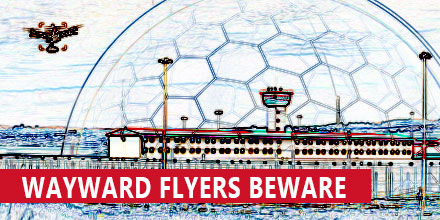Wayward flyers beware, anti-drone hunters are gaining momentum

It was inevitable. Given the vast proliferation of drones, counter-drone measures were simply a matter of time. After all, control of the airspace is a crucial aspect to security.
Drones continued popularity, coupled with decreasing prices and increasing capabilities, also means increased potential for misuse.
Though most drone operators are harmless, the threat still lingers from those who may harbor felonious or malicious intent.
A viable threat from above
News reports of drones flying over prison yards to deliver contraband, are just one such example. Drones wandering into the flight path of commercial airlines, another. These incidents are serious enough to garner the attention and concern of security experts and firms from around the world.
No Drone Fly Zones are now common occurrences around high profile events – from the Super Bowl to the World Economic Forum in Davos, Switzerland – in an effort to secure critical airspace.
Effective enforcement of these zones has been problematic. But that’s starting to change.
Drone hunters at work
Today, anti-drone technology is emerging at a rapid pace. In fact, by 2023, the anti-drone sector is predicted to be a billion-dollar industry.
As of now, a few key players are attempting to position themselves to dominate the industry.
Most anti-drone technology uses a variety of systems – from audio sensors and frequency scanners to cameras – to detect incoming threats. However, the detection and disabling capabilities of today’s anti-drone systems vary from product to product. Detect – Track – Neutralize are the commonalities but how they accomplish those goals vary widely.
Protection via data aggregation
Founded in 2014, Dedrone is a front-runners in the drone deterrent arena. Its software platform detects and provides early warning of aerial intrusions.
Almost all commercial drones depend on radio signals to operate – from receiving control commands to transmitting data. Dedrone exploits this dependency by honing in on these RF signals.
DroneTracker’s RF sensor continuously searches a wide frequency band and then classified and decodes these signals. This all works to provide early warning – often before drones are even airborne. The DroneTracker comes equipped with a Wi-Fi sensor as an additional signal source. It can detect drones controlled by WLAN or who use Wi-Fi hotspots for video transmission. In some cases, it can also read the devices’ MAC addresses so as to identify individual makes and models.
If laws permit, jamming transmitters can be deployed to bring the drone down from the sky. Currently, Dedrone provides protection for data centers, prisons, airports and other critical facilities from corporate espionage, smuggling, terrorism, and hacking.
Shield of protection
Similar to an umbrella with the protected asset sitting in the middle, the shield is a favored method that provides 360° coverage. Both the Drone Shield and the Drone Dome incorporate this concept – though the scope and means of providing coverage differ.
The Drone Dome, designed by an Israeli technology firm, detects and neutralizes hostile drones by using radar and cameras. Once a detected threat attempts to enter a prohibited flight area, Drone Dome alerts the operator. If the incursion continues, the system can disrupt the drone’s electronic systems and end its flight. There are additional ways to disrupt the drone’s flight via satellite navigation interference and radio jamming systems.
DroneShield, based in Australia, implements various technologies to fight illegal drone incursions. The company offers a “shield” approach that uses acoustic sensing to detect incursions. It then provides security alerts in real-time.
First adopters of this technology include prison systems seeking to prevent contraband drops over prison walls.
The big guns
DroneGun is the latest technology introduced by DroneShield. Dubbed a tactical drone jammer, DroneGun forces the wayward drone into a vertical landing or returns it to its starting point. It does not destroy the drone. Weighing over 10 pounds, has a one mile range and implements a variety of jamming measures.
CyberRifle, designed by the Army Cyber Institute at West Point, uses antenna, Wi-Fi radio and a cheap computer to detect weaknesses in a drone to power it off and send it crashing to the ground. It is inexpensive to build, makes no noise, uses no projectiles. Instead, radio signals are the drone’s kiss of death.
Scoop and drop
SkyWall takes a much different approach. Its shape and form more closely resembles a bazooka but it doesn’t launch missal, it launches a net. An intruding drone is lined up and a “smart scope” calculates the drone’s distance and vector so the operator knows exactly where to aim. The net deploys, wraps around the drone effectively disabling its flight. A parachute gently brings the catch to the ground.
The future of anti-drone technology
Currently, the Federal Communication Commission prohibits the “operation, marketing or sale of any type of jamming equipment.” The FCC is concerned about the risk such jammers pose to critical public safety communications, law enforcement communications, and interference with people making 9-1-1 and other emergency calls.
Until laws change, any anti-drone technology reliant on jamming equipment will remain unavailable to the general public. Another deterrent is simply the costs associated with these systems. For now, anti-drone systems are mostly viable options for prisons, airports and other high-target assets. However, as drones continue to populate the skies, the emergence of low-cost, consumer friendly anti-drone systems is simply a matter of time.

